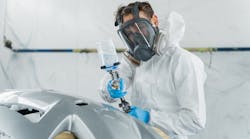Production management, an evolving role in many of today’s body shops, has been around for quite a while, especially in larger shops. While many shops fill this role with the manager overseeing production as well as the front office, as shops grow in size and vehicles become more complex this becomes more difficult.
At the same time that shops are taking on more administrative tasks, and dealing with the ever-changing landscape of calibrations, scans and advanced materials, all shops are still faced with the regular business pressures of cycle time, CSI and evolving OEM recommendations — which we should start calling requirements, rather than recommendations.
The role of the production manager touches all of the above in most shop environments. As a manager, the production manager is expected to be a leader, mentor and trainer and oversee quality control. It seems that there is little in the shop production area that isn’t affected by the production manager.
Production managers grow out of the production area, perhaps a lead technician, or parts manager, some come from the office or blue-printing area. No matter where they started, once they become a production manager, they soon find their role can be challenging, and also rewarding.
Challenges
One of the challenges that I have heard from production managers boils down to the job description. While for many people, job descriptions are fairly well understood, the production manager’s role can vary significantly from shop to shop. So it is not uncommon for a production manager joining a team with prior experience to be challenged with new responsibilities or less authority to make decisions. My take-away is there needs to be a well written job description and understanding of both authorities and responsibilities.
Other challenges include the wide variety of tasks and skills needed (depending on the job description) for this job. A partial list might include: updating the management system, communicating with production and office staff, working with vendors, planning and coordinating training, equipment maintenance management, HR and personnel activities, customer contact, cheer leader and team motivator as well follow up, follow up and more follow up.
Scheduling both internal staff and third-party vendors that may be doing work onsite often doesn’t leave room for a Plan B. Take for instance if a technician is out, even for a single day. If the vehicle is on the schedule for a trip to the dealership, alignment shop or even on-site glass work, this could mean more than a one-day delay, depending on the schedule of others. React to personnel changes immediately to mitigate chain reactions down the road.
There is so much to keep track of (all production) and so many people who need to know about what is happening with the vehicles. While some see this as a challenge, several of the folks I spoke with found technology both simple and advanced as their friend. A simple white board maintained can show everyone at a glance where each vehicle is in the process and the expectations. While this can eliminate a lot of questions, it does require updates throughout the day. Quite a few shops have been using tablets or laptops with software that allows real-time updates to the management system. Most still carry a notepad for scribbling quick reminders or items for follow-up, calls to make or questions that need to be asked. The new management system technology is great, but don’t toss out that yellow legal pad just yet.
With so many things involved that can affect cycle time — being aware of personnel issues, parts delays and even making sure the shop has the right equipment ready to go — it can be a challenge to monitor everything. Most production managers that I spoke with have visual clues throughout the shop. Simple things such as having a copy of the parts order on the actual parts cart and highlighting parts as they arrive and are verified means that at a glance everyone can see if something is missing. When shop equipment has its own place (5S – Sort), for example when a welder or battery charger is where it belongs, it is an easy visual reminder. Other visual clues can include markings on the windshield and other non-verbal communication. Text messages, emails, voice messages and even faxes still have a role. Use all the communication channels or methods as best fits; they are great time savers, but they don’t replace the face-to-face that we all still want.
A production manager needs to be very familiar with the shop’s management system. These tools have evolved too much to try and include everything in this article. Some of the favorites reports include: Target Delivery Report, Rental Car Cycle Time, Reports by Technician. These systems are well designed, allow for multiple methods of communication (email, text, phone call reminders), all the while keeping track of all communication and notes. Great job information providers; you have built some great tools.
Management systems and reports are capable of crunching large amounts of data, provided there are fed properly (kept updated). What they don’t do is provide a large score board, and people want to know the score. Large video screens or white boards with simple, clean, colorful “scores” can drive friendly competition and show people that their contribution matters. Without a score board, who knows who is winning?
The single most important job of the production manager is probably the ability to communicate both verbally and non-verbally, with staff and business partners. Communication with the management system, both with data and reports extracted and notes and information input is vital. They must listen and understand what people are saying, along with being heard.
The wording of questions can make a big difference. For example: Did all the parts come in for this Toyota? Verses have we mirror matched all the parts for this Toyota? Both questions are similar, but the second sure communicates a little more. Or do you have the OEM specs/procedures for this vehicle? Verses do you have the newest specs/procedures? Again similar, but the second covers a lot more ground. It is not just what is said or asked; it is how it is said or asked.

